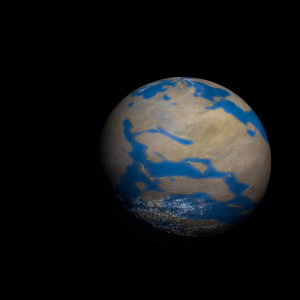|
|
Space Astro
|
Info for exoplanet "Polydes Hoe"
| Scientific (actual) data |
|---|
| Planet | Kepler-1505 b |
| Planet status | Confirmed |
| Radius | 0.083 |
| Orbital period | 30.8609 |
| Discovered | 2016 |
| Updated | 2021-02-05 |
| Tconj | 2454970 |
| Publication | Announced on a website |
| Detection type | Primary Transit |
| Alternate names | 2MASS J19280049+4147130 b, K03456.01, KIC 6364582 b, KOI-3456 b, KOI-3456.01, WISE J192800.49+414713.1 b |
| Star name | Kepler-1505 |
| Right ascension | 292° |
| Declination | 41.79° |
| Mag j | 11.83 |
| Mag h | 11.497 |
| Mag k | 11.406 |
| Star distance | 359 |
| Star metallicity | -0.18 |
| Star mass | 0.93 |
| Star radius | 0.86 |
| Star age | 1.7 |
| Star temperature | 5686 |
| Star alternate names | 2MASS J19280049+4147130, KIC 6364582, KOI-3456, WISE J192800.49+414713.1 |
| Wikipedia article | Kepler-1505 b |
Back
| |
| Fictional info (?) |
|---|
| Suggested name | Polydes Hoe |
| Planet type | Cold planet |
| It is the second-brightest natural object in the night sky after Thone, reaching an apparent magnitude of -5 - bright enough to cast shadows at night and, often, visible to the naked eye in broad daylight.
This cold planet is named after the deity Polydes Hoe, the creator of prosperity.
Polydes Hoe is shrouded by an opaque layer of highly reflective clouds of sulfuric acid, preventing its surface from being seen from space in visible light. Polydes Hoe's surface is a barren desertscape interspersed with slab-like rocks and is periodically resurfaced by volcanism.
Because of its fast rotation, the planet's shape is that of an oblate spheroid (it has a slight but noticeable bulge around the equator). Surrounding Polydes Hoe is a thin planetary ring system and a powerful magnetosphere.
Its north and south poles, therefore, lie where most other planets have their equators. |
| Atmosphere | Water vapor | 49% |
| Hydrogen | 29% |
| Helium | 8.9% |
| Hydrogen peroxide | 7.9% |
| Ammonia | 2.5% |
| 2H2O | 1.5% |
| Methane | 0.61% |
| Sulfur dioxide | 0.15% |
| Carbon dioxide | 0.024% |
| Argon | 0.017% |
| Atmospheric pressure | 90 bar |
 |
| No known satellites |
| Google search for Polydes hoe |
|
Website by Joachim Michaelis
|
|
|
|